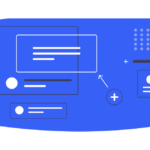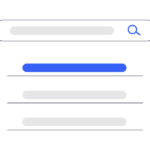7 Tips for Writing Helpful Content for Patients [Part 3]
Writing useful content is one of the most underrated aspects of creating a great user experience.
In part 2 of this blog series, we outlined how most patients find your site via search, and that your site is one of many tabs they have open during that search.
One of the first ways you may entice people to stay on your site is through the quality of your content.
Patients aren’t looking for medical jargon or complex terms; they just want to know what their options are and how to get the best care possible.
In order to make sure your website is helpful and trustworthy, here are a few useful tips for health-related information:
#1: Help visitors skim your content
“What? Do you mean I should encourage visitors to skip over my resources? Doesn’t that defeat the entire purpose of helping them?”
Yes and no.
The reality is that most visitors will skim your content.
You can fight it, or you can use it to your advantage.
Visitors typically skim content because they’re looking for something specific. They may already know parts of what you’ve written.
By using headlines, subheadings, and bullet points, you can help them find what they’re looking for quickly and easily.
Because let’s face it:
How many times have you skimmed an article before deciding whether or not to commit to reading it?
If you make your content skimmable, a visitor just might stick around to actually read it.
#2: Write for a 13-year-old
This may seem like a no-brainer, but it’s important to remember that not everyone reading your content is a medical professional.
In fact, most visitors can’t read beyond an eighth-grade reading level.
This can be a problem if your content was written or edited by a medical professional (who probably isn’t a trained copywriter).
After all, just because your article is medically accurate doesn’t mean people can understand it.
You don’t need to dumb down your content, but you should avoid using jargon and complex terms.
If you’re not sure whether a word is too complex, try looking it up on the Merriam-Webster website. They provide a “simple definition” for most words.
You can also use the Hemingway Editor to check the reading level of your content. Just paste your text into the editor and it will highlight any areas that need to be simplified.
Both of these tools are free, so there’s no excuse for not using them!
#3: Match tone to a visitor’s emotional state
People who are looking for health information can be in different emotional states. They might be scared, confused, or hopeful.
Your tone of voice should match the emotional state of the person reading your content.
If someone has been recently diagnosed with a serious disease, which content do you think will be more valuable to them?
- A dry medical journal describing the science behind their condition
- A compassionate article explaining what’s happening to them and what they should do next
There is a place for both types of content, but the emotional state in which it’s consumed makes all the difference.
You don’t have to skimp on the medical information, but you can deliver it in a helpful, reassuring tone.
If you’re not sure what tone to use, consider using a tool like the Tone Analyzer. Just enter a sample of your writing and it will analyze the tone for you.
Of course, nothing beats actually talking to your target audience. If possible, interview them about their concerns and needs.
This will give you valuable insights that you can use to improve your content.
#4: Connect your content to other areas of the site
At first, people who visit your website care about whether the article they are reading matches their search intent.
But assuming you answered their question, your next job is to help them understand the other information and services your organization provides.
For example, if someone is reading an article about cancer, they might want to know more about the disease itself or how to find a treatment center.
You can help them by linking to other resources on your site (or even external resources).
This is also where having a well-organized website comes into play.
Here are some examples of site elements that serve as guideposts to encourage new visitors to explore your site:
- Navigation
- Categories
- Types of content
This not only helps the visitor but also helps improve your website’s SEO. Google loves sites with a good information architecture because it makes it easier for crawlers to index your content.
Just remember:
You want everything on your page (even the navigation, sidebars, and footer) to reinforce that visitors are in the right place, and encourage them to explore.
#5: Ensure your content is accurate
Medical information can change quickly. Especially if you cover the latest developments in your issue space, your content can fall out of date.
Outdated content can become an issue if you allow it to remain on your site to be found through your navigation, on-site search, or Google.
If someone finds an article that’s out of date, they might not trust the rest of your content.
Worse, they could make decisions based on outdated information (like using an old treatment method).
You can prevent this by regularly reviewing and updating your content.
Content governance is a process that can help you keep track of your content and ensure it remains accurate. It includes things like creating an editorial calendar, setting standards for quality, and establishing a review process.
When publishing a new piece of content, consider whether you can support regularly reviewing it and keeping it up to date over the years.
#6: Be the best option in the search results
We’ve said it many times already: your site is one of many tabs a patient has open during their search.
So, it’s not enough to just write good, helpful content.
If you want to keep a visitor, you have to be the best option available in the search results.
How do you do this?
First, analyze your competitors. “Competitor” can be a dirty word in the nonprofit space, but when it comes to search results, the reality is you are competing for people’s attention.
A competitor analysis will help illuminate what’s working well for other sites like yours and where there might be opportunities for you to improve.
It will also help you see the “white space” in your issue area, and what topics or angles other nonprofits or health sites may not be covering.
Second, research the top search results before you write about a topic. Reading similar articles will help you discover:
- What’s already been covered
- What types of content (e.g., lists, deep-dives, or personal stories) are most popular for that topic
- Ideas for how to differentiate your content and deliver more value
#7: Write for mobile
If you look at your analytics, chances are, most people read your content on their phones.
What does this mean for you?
It means your content needs to be optimized for mobile.
Now, there is a difference between optimizing your design for mobile and optimizing your content for mobile.
Having a mobile-friendly site is one thing. Having mobile-friendly content is another.
Mobile-friendly content means using short paragraphs, bulleted or numbered lists, and clear headlines.
It also means using images, infographics, and videos, where appropriate, to break up your text and make your content more visually appealing.
Remember: people are looking for information on their phones while they’re on the go. They don’t have time to wade through long paragraphs of text.
By making your content mobile-friendly, you’re more likely to hold their attention and deliver the information they need.
Conclusion
Following these tips will help you create useful and trustworthy content for patients.
Keep in mind that your goal is to provide them with the information they need so that they can make informed decisions about their health.
If you earn a visitor’s trust, it is more likely they will continue to explore your site, return again, or convert to an email subscriber, donor, or volunteer.
In part 4, we’ll cover how to organize your patient resources in a way that encourages exploration and helps visitors find related content. Stay tuned!







